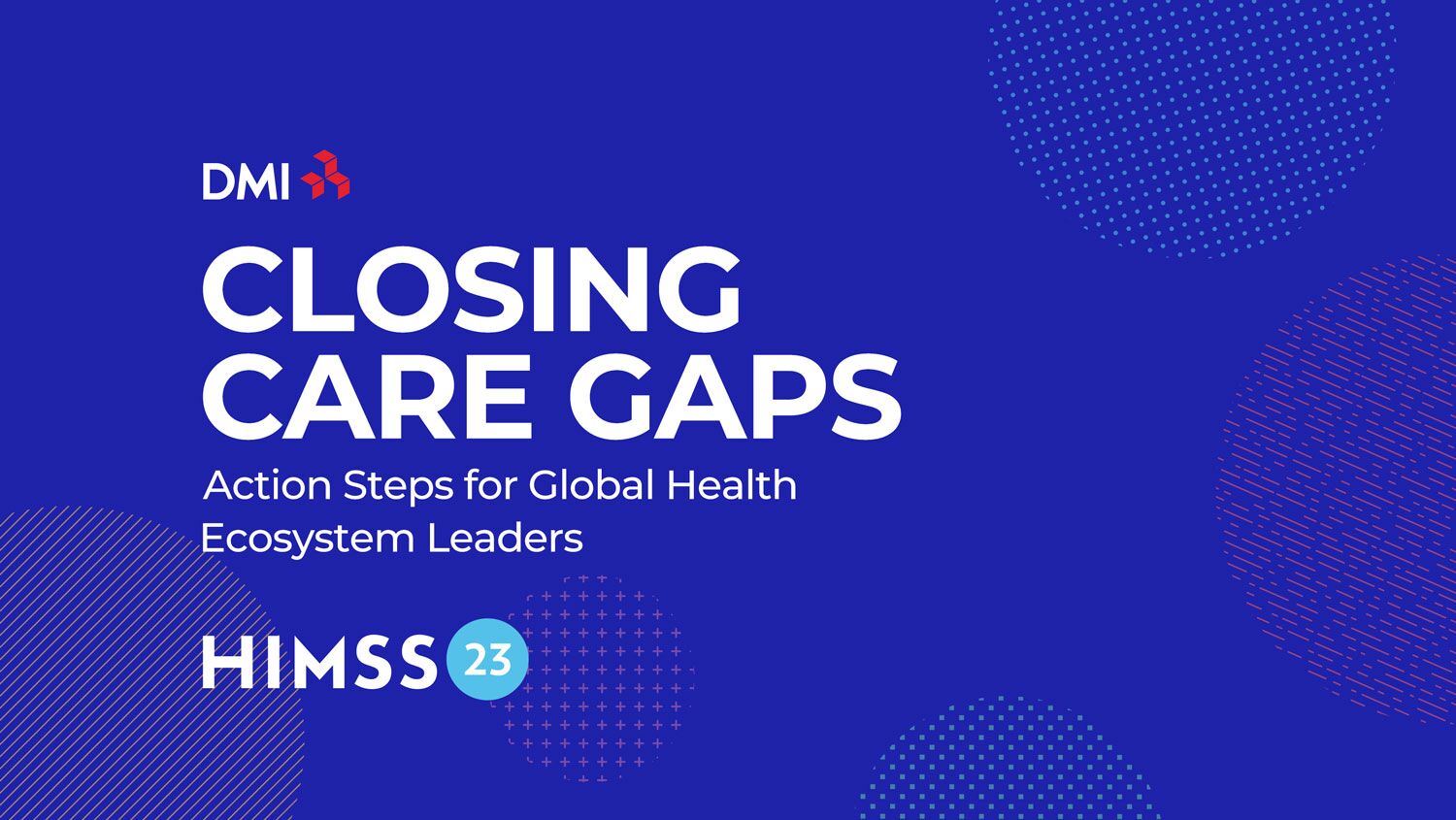Closing Care Gaps: Action Steps for Global Health Ecosystem Leaders
A look across the post-pandemic healthcare landscape underscores this reality: Public health is the product of an integrated — and often interdependent — global ecosystem of public and private entities. Real progress towards closing care gaps requires leaders of payer, provider and government organizations to work in sync to design meaningful interventions.
At the 2023 HIMSS Global Health Conference & Exhibition DMI led a panel discussion focused on the contributions and interventions that payers, providers and government organizations can make to close care gaps within the global health ecosystem.
During the panel, DMI’s Timo Loescher, VP, Strategy, invited industry thought leaders to join a Gaps in Care coalition. He also introduced the Slope of Intervention, a framework that outlines the three main types of interventions that can reduce care gaps, leading patients upward from immediate corrective interventions to gap avoidance and prevention.
“Data shows us that costs and health outcomes are strongly correlated to the number and severity of chronic conditions,” said Loescher. “If we can help drive healthier behaviors and more preventative care, we can also drive down the prevalence of chronic conditions and see significant benefits across our healthcare ecosystem.”
Action Steps for Ecosystem Leaders
During the panel discussion, which also included DMI’s Pankil Patel, Vice President – Federal Health IT, and Saumya Sanjeev, Vice President & Senior Partner, the thought leaders shared action steps that payers, providers and government leaders can take now, and in the coming days and months, to evolve and enhance their contributions and interventions.
Payers
Payers are in a strong position to serve as quarterback over segment identification, but they would benefit by working more closely with providers to leverage data and predictive analytics on existing patient data. This would enable them to do more to personalize their engagements with patient populations.
Key action items:
- Connect with providers to exchange data and insights about the best conditions to target and the most effective patient engagement modalities for those conditions, and jointly develop best practices that nurture trust among patients.
- Determine the technology, data, and connections needed to drive broader population health through customized preventative engagement strategies for your communities.
Providers
Providers should be thinking about how they can collaboratively expose their clinical data without sacrificing privacy and trust. They are in a critical position to help payers marry more in-depth data with their broader vantage point into patient population care gaps.
Key action items:
- Connect with payers to exchange insights about engagement tools and solutions that can help to bridge information gaps and break down barriers to participation and engagement.
- Leverage the vast clinical data at your disposal by supplying it to payers and develop accountability checks to ensure they use the info to better patient outcomes. Ensure they are incentivized to improve population health for their member bases.
Government
Government leaders can play a key role in helping to continue shaping clinical guidelines and data practices. They can also help to drive health campaign initiatives and facilitate the reasonable and secure exchange of data between providers and payers — while, of course, upholding the patient’s right to information security and protection.
Key action steps:
- Spearhead programs, including public-private partnerships, that aim to move patients up the Slope of Intervention towards a preventative mindset.
- Build relationships between payers, providers, and trusted community organizations who can help to deliver and amplify key information among underserved patient populations
Engagement + Agility
As patient populations become more engaged, the benefits extend beyond the closure of care gaps.
Members who are more engaged with their payers, for example, are also more likely to monitor their own health conditions and proactively seek medical advice. Highly engaged customers are also 48% more likely to consider their payer easier to work with.
Effective engagement can also bolster an organization’s ability to adapt with agility to changing preferences and trends in the industry. During the panel discussion, Loescher emphasized the importance of leveraging data and engagement insights to declare value hypotheses and identify the KPIs that can validate the value recognition in those solutions.
“Without intentional measurement, solutions such as these can feel good but not actually drive the impact to the degree that you might have hoped,” he said. “By focusing on tracking and reviewing the larger dataset of metrics, you can avoid the tendency to create solutions not just for individuals but for …populations, making outsized impacts in your communities.”
DMI prides itself on supporting major players across the healthcare industry: life sciences and biopharma developers, state and federal government health agencies, payers, providers, biomedical engineering firms, regulated manufacturers, and educational institutions. We believe that all have their unique perspectives, skill sets, data, and ideas that can be combined to improve patient outcomes, and we are excited to help foster those cross-cutting collaborations. Connect with our team to learn more about the Gaps in Care coalition we are building.


